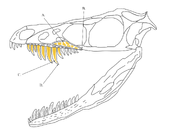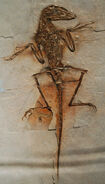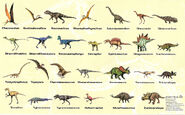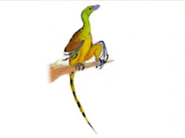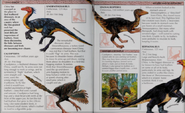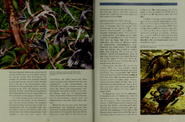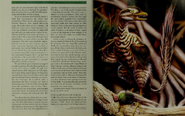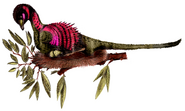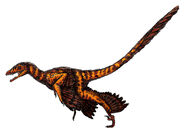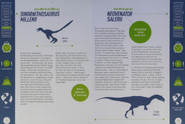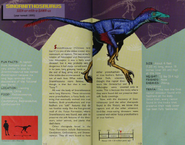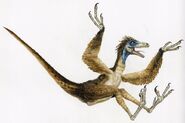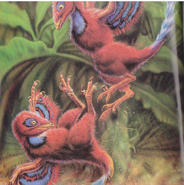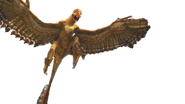| Sinornithosaurus Temporal range: Early Cretaceous | |
|---|---|
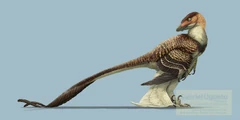
| |
| Sinornithosaurus millenii reconstruction by Gabriel N. U. | |
| Scientific classification | |
| Kingdom: | Animalia |
| Phylum: | Chordata |
| Class: | Sauropsida |
| Superorder: | Dinosauria |
| Order: | Saurischia |
| Suborder: | Theropoda |
| Genus: | †Sinornithosaurus Xu, Wang, & Wu, 1999 |
| Species: | S. millenii |
| Binomial name | |
| Sinornithosaurus millenii Xu, Wang, & Wu, 1999 | |
Sinornithosaurus (derived from a combination of Latin and Greek; meaning 'Chinese bird-lizard') is a genus of feathered dromaeosaurid dinosaur from the early Cretaceous Period (early Aptian) of the Yixian Formation in what is now China.
Description[]
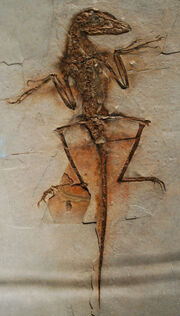
Fossil of Sinornithosaurus, showing preserved feathers
It was the fifth non–avian feathered dinosaur genus discovered by 1999. The original specimen was collected from the Sihetun locality of western Liaoning. It was found in the Jianshangou beds of the Yixian Formation, dated to 124.5 million years ago. Additional specimens have been found in the younger Dawangzhangzi bed, dating to around 122 million years ago. Xu Xing described Sinornithosaurus and performed a phylogenetic analysis which demonstrated that it is basal, or primitive, among the dromaeosaurs. Specimens of Sinornithosaurus have preserved impressions of feathers both covering the entirety of the body and forming the wings. These feathers were indistinguishable in form from those found on birds from the same geological deposits. The body (contour) feathers were generally between 3–4.5 cm long and included two types: the first type are formed of several filaments joined into "tufts", similar to modern down feathers. The second type, including those on the arms, were composed of rows of filaments (barbs) joined along a main shaft (rachis), making them similar in structure to modern bird feathers.
However, unlike the wing feathers of flying birds, they did not have the secondary branches with tiny little hooks (barbules) that flight feathers have, which allow the flight feathers to form a continuous vane. Some scientists have suggested that the feathers might have allowed Sinornithosaurus to glide for short distances after leaping from trees. A 2010 study indicated that Sinornithosaurus may have had feathers which varied in color significantly across different regions of the body, based on analysis of microscopic cell structures in preserved fossils.
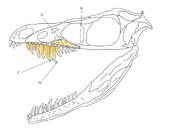
Skull of Sinornithosaurus
Some paleontologists have hypothesized that Sinornithosaurus millenii had venom due to some dentitional similarities to modern venomous snakes. Lately; the possibility that this dinosaur species could be venomous is highly debated.
In the Media[]
- Sinornithosaurus makes an appearance in the episode Feathered Dragons in Planet Dinosaur, where it is first shown to prey on a smaller relative, Microraptor, but fails. Sinornithosaurus is later shown to have a poisonous bite by comparing its teeth to the Gila Monster lizard. A pack of Sinornithosaurus have taken down a mother Jeholosaurus with the help of their poison, orphaning her babies.
- It was seen in the television show Dino Dana. It apparently is shown with a purple-feathered body, whereas the real animal had orange/brown feathers.
Gallery[]
References[]
- https://www.pnas.org/content/107/2/766
- https://australian.museum/learn/dinosaurs/fact-sheets/sinornithosaurus-millenii/
- https://www.smithsonianmag.com/science-nature/sinornithosaurus-probably-wasnt-venomous-after-all-75529149/
- https://www.nhm.ac.uk/discover/dino-directory/sinornithosaurus.html
- https://www.researchgate.net/publication/41040416_The_birdlike_raptor_Sinornithosaurus_was_venomous
- https://www.nationalgeographic.com/science/article/groovy-teeth-but-was-sinornithosaurus-a-venomous-dinosaur
- https://dinosaurpictures.org/Sinornithosaurus-pictures

